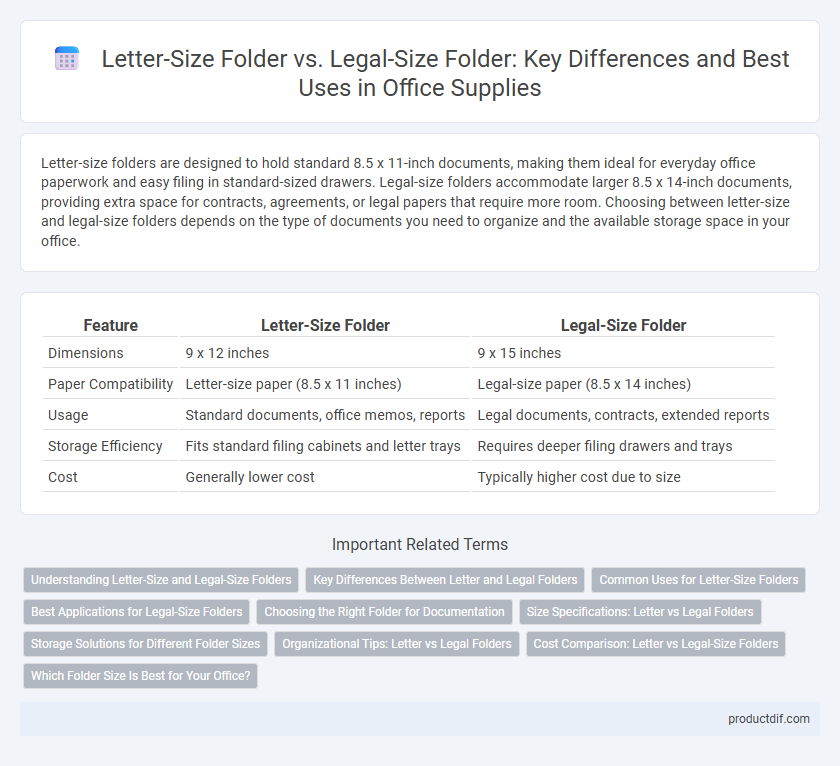Letter-size folders are designed to hold standard 8.5 x 11-inch documents, making them ideal for everyday office paperwork and easy filing in standard-sized drawers. Legal-size folders accommodate larger 8.5 x 14-inch documents, providing extra space for contracts, agreements, or legal papers that require more room. Choosing between letter-size and legal-size folders depends on the type of documents you need to organize and the available storage space in your office.
Table of Comparison
| Feature | Letter-Size Folder | Legal-Size Folder |
|---|---|---|
| Dimensions | 9 x 12 inches | 9 x 15 inches |
| Paper Compatibility | Letter-size paper (8.5 x 11 inches) | Legal-size paper (8.5 x 14 inches) |
| Usage | Standard documents, office memos, reports | Legal documents, contracts, extended reports |
| Storage Efficiency | Fits standard filing cabinets and letter trays | Requires deeper filing drawers and trays |
| Cost | Generally lower cost | Typically higher cost due to size |
Understanding Letter-Size and Legal-Size Folders
Letter-size folders are designed to hold standard 8.5 x 11-inch documents, making them ideal for everyday office use and storing typical paperwork. Legal-size folders accommodate larger 8.5 x 14-inch sheets, suited for legal documents and contracts that require extra length. Choosing between letter-size and legal-size folders ensures proper organization and protection based on document dimensions.
Key Differences Between Letter and Legal Folders
Letter-size folders typically measure 9 by 12 inches and are designed to hold standard 8.5 by 11-inch documents, whereas legal-size folders are larger, measuring 9 by 15 inches to accommodate 8.5 by 14-inch legal papers. The primary difference lies in their length, making legal folders better suited for longer documents such as contracts or legal briefs. Choosing between letter and legal folders depends on the specific paper size requirements and filing needs in office environments.
Common Uses for Letter-Size Folders
Letter-size folders, measuring 8.5 x 11 inches, are commonly used for organizing standard documents such as reports, letters, and invoices in offices, schools, and home workspaces. These folders efficiently store and protect printed materials that fit the typical paper size of printers and copiers, making them ideal for everyday filing tasks. Their widespread compatibility with filing cabinets and desk organizers enhances office workflow and document accessibility.
Best Applications for Legal-Size Folders
Legal-size folders, measuring 8.5 x 14 inches, are best suited for storing extended documents such as contracts, legal briefs, and tax forms that exceed standard letter size. These folders provide ample space to accommodate oversized paperwork without folding or trimming, ensuring important information remains intact and easily accessible. Ideal for law offices, accounting firms, and businesses handling regulatory compliance, legal-size folders enhance organization and protection of critical documents.
Choosing the Right Folder for Documentation
Choosing the right folder for documentation depends on the size of your documents and storage needs. Letter-size folders, measuring 8.5 by 11 inches, are ideal for standard business documents, while legal-size folders, typically 8.5 by 14 inches, accommodate longer legal papers or contracts. Selecting the correct folder size ensures proper organization, prevents document damage, and improves office efficiency.
Size Specifications: Letter vs Legal Folders
Letter-size folders measure 9 by 12 inches, designed to accommodate standard 8.5 by 11 inch documents, offering a compact fit for everyday office use. Legal-size folders, on the other hand, measure 9 by 15 inches, specifically tailored to hold legal-size papers that are 8.5 by 14 inches, providing extra length for extended documents. Selecting between letter and legal folders depends on the document size, ensuring efficient organization and protection based on official paper dimensions.
Storage Solutions for Different Folder Sizes
Letter-size folders measure 8.5 x 11 inches and are ideal for storing standard documents, fitting perfectly in most office drawers and filing cabinets designed with standard dimensions. Legal-size folders, measuring 8.5 x 14 inches, provide extra length for storing legal documents, contracts, and extended reports, requiring deeper storage compartments or specialized filing systems. Selecting storage solutions that accommodate both folder sizes ensures organized document management, preventing damage and maximizing space efficiency in professional environments.
Organizational Tips: Letter vs Legal Folders
Letter-size folders measure 8.5 x 11 inches and are ideal for standard documents such as invoices and client records, promoting efficient filing and easy retrieval in common office filing systems. Legal-size folders, at 8.5 x 14 inches, accommodate longer documents like contracts and legal paperwork, reducing the need for folding and preserving document integrity. To optimize organization, separate files by content type using letter folders for everyday correspondence and legal folders for extended paperwork, ensuring streamlined access and protection of important documents.
Cost Comparison: Letter vs Legal-Size Folders
Letter-size folders typically cost less than legal-size folders due to smaller material usage and higher demand in standard office settings. Legal-size folders, being larger, require more raw materials and have a niche market, leading to higher per-unit prices. Businesses aiming to optimize budget efficiency often prefer letter-size folders for everyday document storage to reduce overall supply expenses.
Which Folder Size Is Best for Your Office?
Choosing between letter-size and legal-size folders depends on the dimensions of your documents and filing needs; letter-size folders typically accommodate 8.5 x 11-inch papers, while legal-size folders fit larger 8.5 x 14-inch documents. Offices handling standard business forms, reports, and correspondence benefit most from letter-size folders due to their compatibility with most printers and filing cabinets. Legal-size folders are ideal for legal, architectural, or financial documents that require extra length to prevent folding or trimming.
Letter-size Folder vs Legal-size Folder Infographic

 productdif.com
productdif.com